|
Prostatic Hypertrophy
Rehabilitation
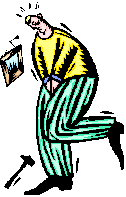
It is known that benign prostatic
hyperplasia or BPH is caused by an overgrowth of prostate cells.
This enlargement constricts the urethra so the flow of urine is
reduced, making it increasingly difficult to empty the bladder.
BPH is very common, affecting about one
third of men over 50. Although it is not prostate cancer, the
symptoms of BPH are similar to those of prostate cancer so you
should see your doctor if you start to experience problems in
passing urine.
Treatment
The mainstays of treatment for BPH are
drugs and surgery. However, as any treatment can have unwanted
effects, some men with mild symptoms opt for "watchful waiting",
where no treatment is undertaken. Instead the situation is
monitored closely with routine check-ups. If symptoms
deteriorate, it is then possible to opt for treatment.
Drug treatment
There are two main classes of drugs that
are prescribed for BPH: alpha-blockers and 5-alpha-reductase
inhibitors.
Alpha-blockers
Work by relaxing the muscles at the neck of
the bladder and in the prostate, so to reduce the pressure on
the urethra and so help increase the flow of urine. They do not
cure BPH but help to alleviate some of the symptoms.
Around 60% of men find symptoms improve
significantly within the first 2-3 weeks of treatment with an
alpha-blocker. There are several different alpha blockers.
Currently, the alpha blockers used include doxazosin (Cardura),
terazosin (Hytrin), tamsulosin (Flomax), alfuzosin (Xatral) and
prazosin (Hypovase). The most common side-effects of
alpha-blockers are tiredness, dizziness and headaches.
5-alpha-reductase inhibitors
These drugs work by inhibiting the
production of a hormone called DHT, which contributes to
prostate enlargement. Finasteride (Proscar) is the most commonly
used drug of this type for BPH. Unlike alpha blockers, 5-alpha-
reductase inhibitors are able to reverse BPH to some extent and
so may delay your need for surgery. Potential side-effects of
finasteride include a reduced sex drive and difficulty in
maintaining an erection. Several months of treatment may be
needed before the benefit is noticed.
Plant extracts
A number of plant extracts are popularly
used to alleviate BPH, although formal evidence that they are
effective is often scanty. However, there is some scientific
evidence that an extract of saw palmetto (called Serenoa repens)
can be beneficial.
Surgery
There are three main surgical options for
BPH:
Transurethral resection of the prostate
(TURP) which is an effective procedure with over 90% of men
reporting an improvement after the operation. However, a common
side-effect of this procedure is retrograde ejaculation - where
semen passes into the bladder during orgasm instead of out of
the penis. This is sometimes called a "dry orgasm". Retrograde
ejaculation is usually not a problem, although it may reduce
fertility. Complications of the operation can include urinary
incontinence or damage to the urethra, resulting in a
"stricture" that can itself cause difficulty passing urine.
Transurethral incision of the prostate
(TUIP). As with a TURP an instrument is passed up through the
penis, but instead of removing a portion of the prostate, small
cuts are made in the neck of the bladder and the prostate. This
reduces the obstruction of the flow of urine.
Open prostatectomy
Open prostatectomy is only recommended for
men whose prostate is very large. It is a major operation and
carried out under a general anaesthetic. An incision is made in
the lower abdomen in order to remove the central part of the
prostate.
Other treatments
Laser therapy (using a laser probe to cut
away prostate tissue) and transurethral microwave thermotherapy
(using heat to remove some of the prostate tissue via a probe)
are becoming more common in the treatment of BPH. The problem
with these technique might be irritative symptoms, post
operative infection, urethral stenosis and retrograde
ejaculation.
Alternative treatment – Traditional
Chinese Medicine (TCM)
Traditional and Current Chinese Medicine
believes that, prostatic hypertrophy is caused by Kidney
deficiency and Spleen deficiency, which again results in
accumulation of heat and damp in urinary bladder. Therefore the
principle in the treatment of prostatic hypertrophy in TCM is to
support the functions of Kidney and Spleen systems, and expel
the accumulated damp and fire in urinary bladder.
The major therapies used in TCM for this
disease include herbal therapy and acupuncture. The herbs are
applied as oral intake or as enema (infusion into colon through
anus),
(Note,
the liver, kidney, spleen and heart systems, as well as the term
of phlegm used in this brochure are the concepts in Traditional
Chinese Medicine, not the ones in Western Medicine.)
Acupuncture
In one study, fifty patients with benign
prostatic hypertrophy were treated with acupuncture. Seventy two
per cent of them experienced dramatic improvement in their
symptoms and only four per cent of them failed to have any
healing effect.
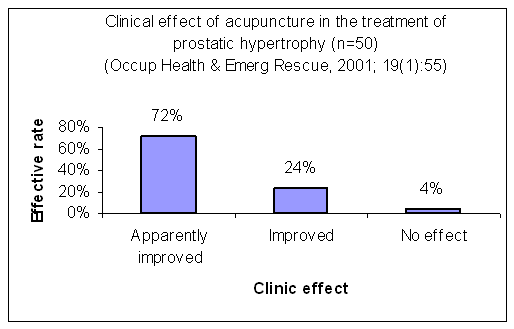
In another study, the combination of
acupuncture, moxibustion and far infrared therapy yielded a cure
rate of 41% in total 32 patients. (Index for cure in this study:
clinic symptoms disappeared, night urine reduces to less than
once, the size of prostate apparently decreases and no residue
urine in urinary bladder).
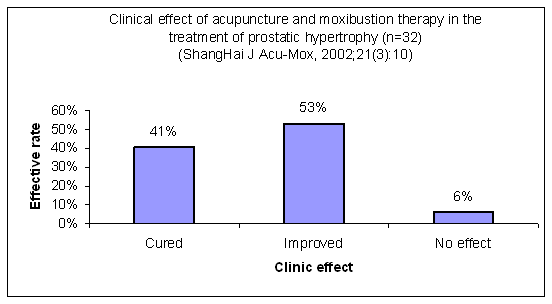
Herbal therapy
In a study, seventy per cent of total sixty
patients with prostatic hypertrophy were cured after
administration of herbal therapy. The degree of prostate
hypertrophy in these patients: degree I, 8 cases, degree II, 47
cases and degree III, 5 cases. Index for cure: clinic symptoms
and signs disappear, size of prostate return normal under ultra
sound B measurement.
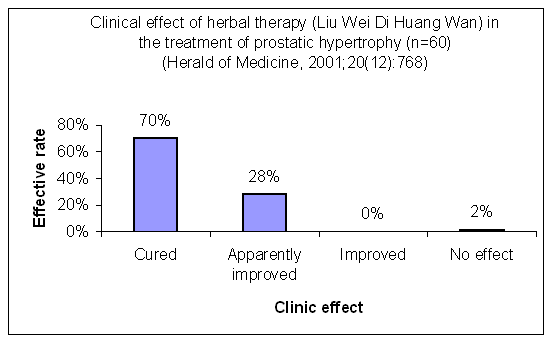
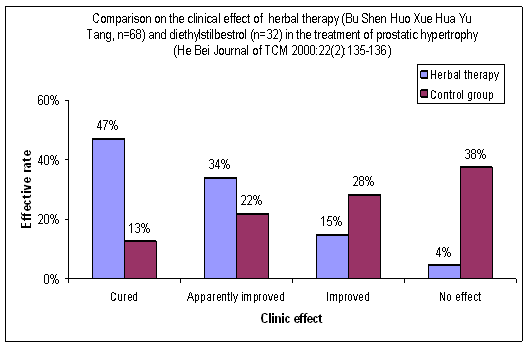
Qigong therapy
Qigong is unique in the treatment of any
disease in that it doesn’t need any clear diagnosis or gives any
medicine. It is a special energy work to improve bio-energy flow
in the body, so said. In one study involving 46 patients with
prostatic hypertrophy, the total effective rate of Qigong
therapy is 100%. Here we should point out that the healing
effect of the Qigong therapy is very much affected by the level
of the Qigong master. The healing ability is very much variable
among Qigong masters.
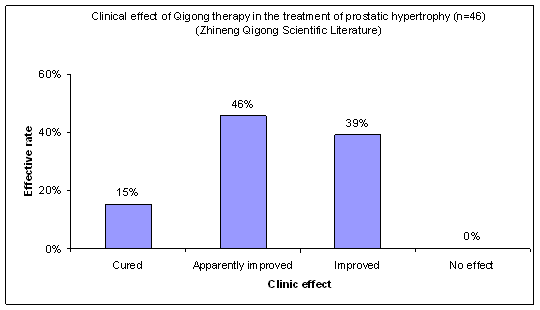
Suggestions for those who suffer
from the prostatic enlargement:
(1). Always consult with your TCM doctor if
he/she can help you with no-harm acupuncture or Chinese herbal
therapy. Currently, the healing effect by TCM is much better
than the conventional medicine.
(2). If one acupuncturist cannot help you,
try another one who can practice both acupuncture and herbal
therapy. The healing ability among acupuncturist is largely
variable. Don’t feel disappointed if one acupuncturist failed to
help you.
(3). You need to change your life style:
restrict sexual activity (including not to dream your loved one
emotionally), but if you feel want to have sex, do it to
complete whole course, do not restrict your activity on the half
way. If you have masturbation, you should tell your doctor to
stop it as soon as possible.
(4). Eat less spice food. Drink less
alcohol-containing beverage.
|














